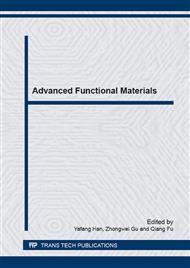p.539
p.545
p.551
p.557
p.562
p.568
p.576
p.583
p.589
Polymerization of Dicyclopentadiene/Styrene in PolyHIPE
Abstract:
A series of porous poly(styrene-divinylbenzene) monoliths (polyHIPE) was synthesized by high internal phase emulsions (HIPE). The effects of the ethanol contents on the microstructure of the polyHIPE were characterized by scanning electron microscopy and mercury intrusion porosimeter. The adsorption and release behaviors of the polyHIPE for a monomer mixture consisting of dicyclopentadiene (DCPD) /styrene (St) (DS, mass ratio of 9/1) were investigated. The polymerization of the mixture DS within pores of the polyHIPE was studied. The results showed that the microstructure of the polyHIPE was significantly influenced by the ethanol content. The increase of ethanol in the HIPE increased the internal pore diameter and decreased the pore volume of the polyHIPE, thus decreased the DS absorption and increased the release rate. The DS monomer can enter the pores(cavities, windows) and fill the original holes after the polymerization. Compared with conventional polymerization of DCPD/St, the poly(DCPD/St) (pDS) obtained from confined spaces possess higher molecular weight, broader molecular weight distribution, and higher Tg. As the pore diameter increased, the effect of space confinement reduced, and the performances of pDS were closed to that prepared by conventional polymerization.
Info:
Periodical:
Pages:
562-567
Citation:
Online since:
March 2015
Authors:
Price:
Сopyright:
© 2015 Trans Tech Publications Ltd. All Rights Reserved
Share:
Citation:


